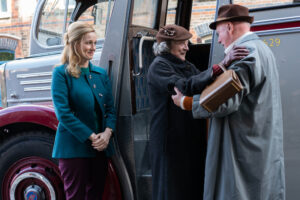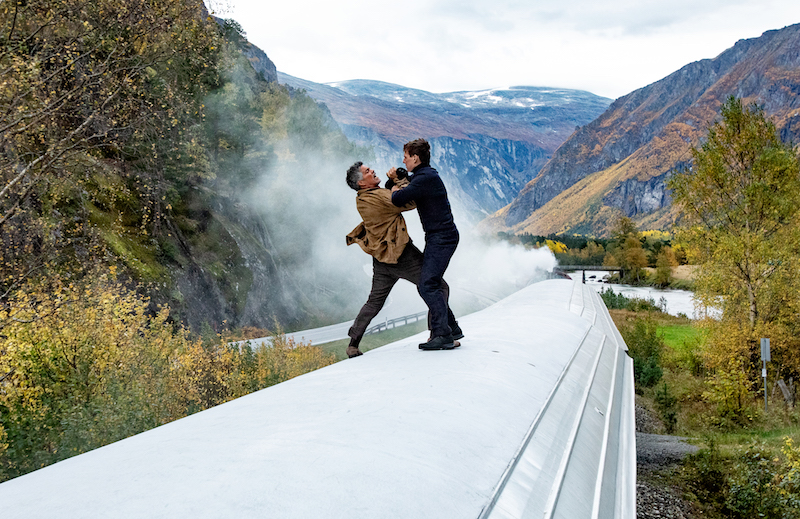What is it about movie characters on speeding trains?
They’re usually in the relative safety of a train car, and, for some reason, they think, “Hey, I’ve got a good idea! I’ll climb outside to the top of the train and run around, maybe get into a fight to the death!”
Sure, it’s dumb. Maybe they do it because they think it looks cool. Whatever the reason, it happens all the time in action/adventure films. It happens in the new “Indiana Jones and the Dial of Destiny.” And it happens in the even newer “Mission: Impossible – Dead Reckoning Part One” (PG-13, 163 minutes, in theaters).

Esai Morales and Tom Cruise in Mission: Impossible Dead Reckoning Part One from Paramount Pictures and Skydance.
The seventh “Mission” in the Tom Cruise franchise – and, as the title suggests, the first of a two-part story – features many of the cliches you come to expect in such a film: an extended car chase, lots of running around (give that Tom Cruise another track trophy!), motorcycle high jinks, hanging from high places, and, yes, the trip to top of the train. And that’s for starters. Let’s not forget those digital clocks that count down to something really bad happening.
The plot is fairly routine: Ethan Hunt (Cruise) and his IMF (Impossible Mission Force) team are assigned (if they choose to accept it, and, no surprise, they do) to track down a missing part of a key that will control an Artificial Intelligence weapon known as “The Entity.” The survival of the world as we know it is at stake (you know, like it always is in these scenarios).
The thing is, “Dead Reckoning Part One” manages to be a lot of fun.

Hayley Atwell and Tom Cruise in Mission: Impossible Dead Reckoning – Part One from Paramount Pictures and Skydance.
Directed by Christopher McQuarrie (who wrote “The Usual Suspects” and has directed two previous “Mission: Impossible” films), it opens with an intense sequence involving a Russian submarine and ends with a hair-raising train sequence (despite the bit involving … well, you know). Throughout, the film offers just the right mix of genuinely thrilling action and intrigue.
Cruise is fine as the ever-cool, superhuman Hunt, but the supporting cast gives the film its oomph. Hayley Atwell stands out, sexy and charismatic as Hunt’s new romantic interest, Grace, a thief. Esai Morales makes a formidable foe for Hunt as the ruthless villain, Gabriel, and Ving Rhames and Simon Pegg are back as Hunt’s colorful colleagues on the IMF. Also in the talented ensemble: Rebecca Ferguson, Vanessa Kirby, Pom Klementieff (Mantis in the “Guardians of the Galaxy” movies), Shea Wigham and Cary Elwes.
Sometimes, for whatever reason, action films will toss in contrived themes: The importance of family in the “Fast and Furious” franchise comes to mind because its movies keep beating us over the head with this big message.
“Dead Reckoning Part One” is much more effective as it deals with a few different questions, including whether some weapons can be trusted by anyone, including “us.” The film goes on to consider the related idea of allegiance, whether it’s to the world at large, our nation, our government, our friends. And then there’s the allegiance to doing what’s right. We see through Hunt and the other IMF members that these allegiances are often in conflict with one another, but that doing what’s right generally turns out to be the group’s top priority.
Of course, doing what’s right is often easier said than done. That’s probably why Ethan Hunt finds himself fighting on top of trains. ***½ (out of four)
‘Miracle Club’ flawed, but uplifting
It’s a privilege to watch Laura Linney and Maggie Smith work together in “The Miracle Club” (PG-13, 91 minutes, in theaters). They play Irish women who have harbored bitterness toward each other for decades, and the scenes in which they reach out – sometimes literally – to each other in order to heal (themselves and each other) are striking in their tenderness.

From left, Laura Linney, Maggie Smith and Niall Buggy appear in a scene from “The Miracle Club.” (Jonathan Hession/Sony Pictures Classics)
Overall, the film, directed by Thaddeus O’Sullivan (“December Bride”), is less successful. But the performances and the themes related to enduring personal connections, forgiveness and the nature of miracles make it rewarding.
It’s 1967, and, after 40 years in America, Chrissie (Linney) returns for the first time to her working-class neighborhood near Dublin for the funeral of her mother. Chrissie hardly gets an enthusiastic welcome; she’s greeted with scorn from her mother’s friends, Eileen (Kathy Bates), and Lily (Smith). They’re angry that she’s ignored her mother for all of these years, but it’s clear that there’s a rocky history among them that goes far deeper than that.
Meanwhile, the local priest (Mark O’Halloran) arranges for a group pilgrimage to the French town of Lourdes, where miracles are said to occur, and Chrissie, Eileen, Lily and a younger woman, Dolly (Agnes O’Casey), are among those who go. While Chrissie’s reasons for going aren’t quite so clear, Eileen and Lily hope for physical healing, and Dolly brings along her young son, who doesn’t speak, in hopes that he will.
Eileen, Lily and Dolly leave their husbands (Stephen Rae plays one) at home, despite their spouses’ protests, and this is where the film’s humor comes into play. Pushed out of their patriarchal roles (remember, this is 1967 Ireland) to look after their offspring and/or themselves, they struggle with carrying groceries, changing diapers, etc. All of this is mildly amusing, but not one of the film’s strengths.
Bates’ Eileen is more of a problem, though through no fault of the actress. The character is hard to read because she’s constantly changing – whether it’s in her attitude toward Chrissie or toward the Catholic Church. This seems less a result of a mercurial temperament and more due to the whims of the screenplay.
Much more convincing, and moving, are the scenes with Linney and Smith, and with O’Casey (great-granddaughter of Sean!) as the young, loving mom. These are the moments that make this modest, well-meaning film come alive, and leave us with hope for humanity. ***
** Click here for Tim Miller’s previous movie columns for Cape Cod Wave **
Please like Cape Cod Wave on Facebook.
Cape Cod Wave Magazine covers the character & culture of Cape Cod. Please see our Longform stories.
Tim Miller is co-president of the Boston Society of Film Critics. He teaches film and journalism at Cape Cod Community College in West Barnstable. You can contact Tim at [email protected] or follow him onTwitter @TimMillerCritic. Or you can ignore him completely.
































